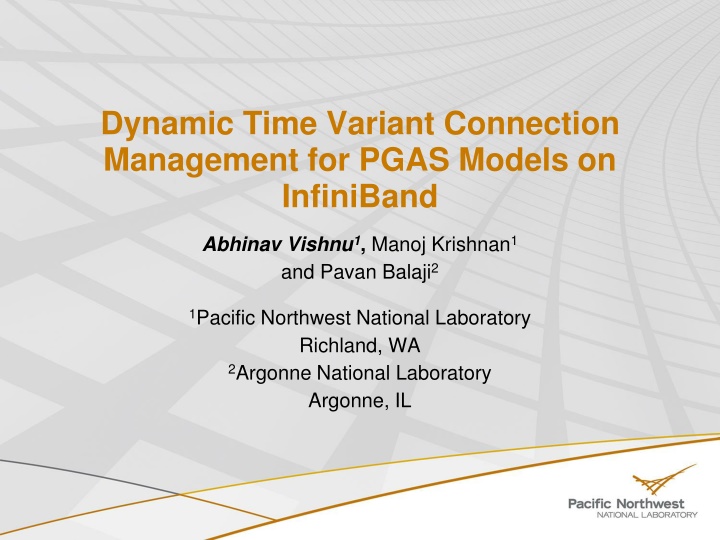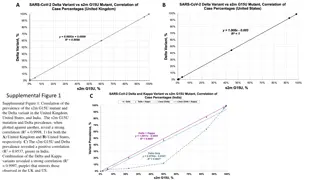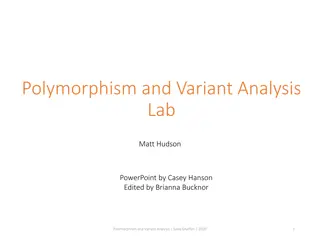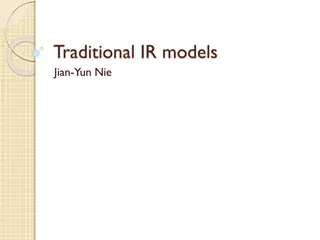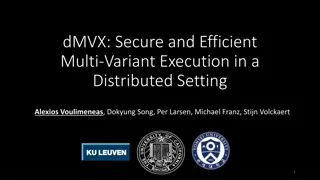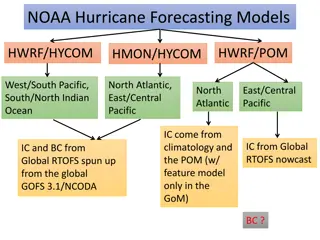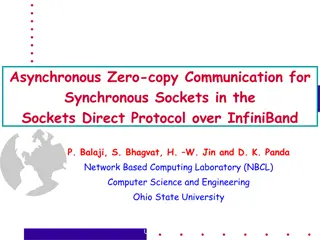Dynamic Time-Variant Connection Management for PGAS Models on InfiniBand
Scalable communication data structures are crucial for runtime systems, with a focus on efficient connection management for PGAS models on InfiniBand systems. The research explores on-demand process creation, persistent connections, use cases, problem statements, and design choices for disconnection protocols.
Download Presentation

Please find below an Image/Link to download the presentation.
The content on the website is provided AS IS for your information and personal use only. It may not be sold, licensed, or shared on other websites without obtaining consent from the author.If you encounter any issues during the download, it is possible that the publisher has removed the file from their server.
You are allowed to download the files provided on this website for personal or commercial use, subject to the condition that they are used lawfully. All files are the property of their respective owners.
The content on the website is provided AS IS for your information and personal use only. It may not be sold, licensed, or shared on other websites without obtaining consent from the author.
E N D
Presentation Transcript
Dynamic Time Variant Connection Management for PGAS Models on InfiniBand Abhinav Vishnu1, Manoj Krishnan1 and Pavan Balaji2 1Pacific Northwest National Laboratory Richland, WA 2Argonne National Laboratory Argonne, IL
Outline Introduction Background and Motivation InfiniBand Connection Semantics Global Arrays and ARMCI Overall Design Efficient Connection Teardown Connection Cache Management Performance Evaluation Computational Chemistry Sub-surface modeling Conclusions and Future Work
Introduction For runtime systems, scalable communication data structures is critical Communication data structures Buffers (data, control messages ..) Connections End-points (Gemini, Seastar, BG ..) One-to-one mapping (IB)) Registration data structures (Local for MPI, Local + Remote for PGAS) . Efficient connection management is important 213 InfiniBand systems in TOP500 PGAS Models are becoming popular 3
InfiniBand Connection Management On-demand pair-wise process creation Cluster 02 (VIA), IPDPS 06, Cluster 08 (IB-MPI), CCGrid 10 (IB- PGAS) Persistent through the application lifetime Unreliable datagram based approaches (ICS 07) Natural fit for two-sided communication (send/receive model) Designing get and bulk data transfer is prohibitive Software maintained reliability eXtended Reliable Connection (XRC) Connection memory increases with nodes and not processes (ICS 07, Cluster 08) 4
Use Cases for PGAS Models Frequently combined with non-SPMD execution models Task Based Computations Dynamic load balancing and work stealing Linear communication over the application execution lifetime Time-Variance in execution Little temporal reuse (SC 09) Connection persistence is not useful 5
Problem Statement Given low temporal locality for PGAS models and non- SPMD executions What are the design choices for a disconnection protocol? What are the memory benefits and possible performance degradations? 6
Outline Introduction Background and Motivation InfiniBand Connection Semantics Global Arrays and ARMCI Overall Design Efficient Connection Teardown Connection Cache Management Performance Evaluation Computational Chemistry Sub-surface modeling Conclusions and Future Work
InfiniBand Transport Semantics Reliable Connection Most frequently used Supports In-order delivery, RDMA, QoS .. Reliable Datagram Most RC features, but .. Unreliable Connection RDMA, requires dedicated QP No ordering Unreliable Datagram Connectionless limited message size to MTU No ordering or reliability guarantees 8
Global Arrays Global Arrays is a PGAS programming model GA presents a shared view Provides one-sided communication model Used in wide variety of applications Computational Chemistry NWChem, Molcas, Molpro Bioinformatics ScalaBLAST Ground Water Modeling STOMP Physically distributed data Global Address Space 9
Aggregate Remote Memory Copy Interface Communication Runtime Systems for Global Arrays Used in Global Trees, and Chapel Provides one-sided communication runtime primitives Currently Supported Platforms Commodity Networks InfiniBand, Ethernet .. Leadership Class Machines Cray XE6, Cray XTs IBM BG s On-going -> BG/Q and BlueWaters Upcoming features Fault tolerant continued execution (5.1) Energy Efficiency modes (5.2) 10
Outline Introduction Background and Motivation InfiniBand Connection Semantics Global Arrays and ARMCI Overall Design Efficient Connection Teardown Connection Cache Management Performance Evaluation Computational Chemistry Sub-surface modeling Conclusions and Future Work
Connection Structure in ARMCI Client Process Data Server thread Master Process 12
Connection Cache Management Number of active connections Model? Dynamic behavior for task-based computations Finding a victim connection LRU LRU insufficient with communication cliques Multi-phase applications (use-case: Flow + Chemistry) Modified-LRU (LRU-M) Temporal locality of connections 13
Overlap Disconnection Protocol Master Process Data Server Client WaitProc Flush Teardown Req Time break break Acknowledgement 14
Outline Introduction Background and Motivation InfiniBand Connection Semantics Global Arrays and ARMCI Overall Design Efficient Connection Teardown Connection Cache Management Performance Evaluation Computational Chemistry and Sub-surface Modeling Conclusions and Future Work
Performance Evaluation Evaluation Test Bed 160 Tflop system with 2310 Dual socket quad core Barcelona processor InfiniBand DDR with PCI Express using DDR Voltaire switches Original implementation is Global Arrays (GA) version 4.3 The presented design is available with GA-5.0 Methodologies LRU, and LRU-M Varying the number of connection entries in connection cache Applications Northwest Chemistry (NWChem) Sub-surface Transport on Multiple Phases 16
Performance Evaluation with NWChem Evaluation with pentane input deck on 6144 processes The connection cache has a total of 128, 32, and 4 entries Negligible performance degradation for 128 and 32 cache size Total connections created 91-117 3-4 times for 32 cache size ~32 times for 4 cache size 17
Performance Evaluation :NWChem (Contd) Evaluation with siosi7 input deck on 4096 processes The connection cache has a total of 128, 32, and 4 entries Negligible performance degradation for 128 and 32 connection size Total connections created 93-121 3-4 times for 32 cache size ~32 times for 4 cache size 18
Performance Evaluation :STOMP Evaluation on 8192 processes The connection cache has a total of 128, 32, and 4 entries LRU-M reduces the overall connection establishment and break time in comparison to LRU 19
Conclusions and Future Work Persistent on-demand connection approaches are insufficient Presented a design for connection management Efficient connection cache management A conducive protocol for PGAS Models Memory benefits for two class of applications Future Work: Solve the problem for two-sided (pair-wise) connections Apply the problem to other communication data structures (remote registration caches) 20
Questions Global Arrays http://www.emsl.pnl.gov/docs/global/ ARMCI http://www.emsl.pnl.gov/docs/parsoft/armci/ HPC-PNL http://hpc.pnl.gov 21
